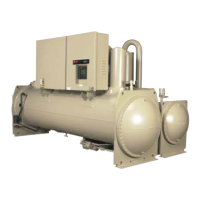RTHD-SVX01D-EN 79
Operating Principles Mechanical
The compressor used by the Series R chiller consists of three distinct sec-
tions: the motor, the rotors and the bearing housing. Refer to Figure 24.
Compressor Motor
A two-pole, hermetic, squirrel-cage induction motor directly drives the com-
pressor rotors. The motor is cooled by suction vapor drawn from the evapora-
tor and entering the end of the motor housing (Figure 24) .
Compressor Rotors
Each Series R chiller uses a semi-hermetic, direct-drive helical rotary type
compressor. Excluding the bearings, each compressor has only 3 moving
parts: 2 rotors - “male” and “female” - provide compression, and a slide valve
that controls capacity. See Figure 24. The male rotor is attached to, and
driven by the motor, and the female rotor is, in turn, driven by the male rotor.
Separately housed bearing sets are provided at each end of both rotors on
the RTHD units. The slide valve is located below (and moves along) the
rotors.
The helical rotary compressor is a positive displacement device. Refrigerant
from the evaporator is drawn into the suction opening at the end of the motor
section. The gas is drawn across the motor, cooling it, and then into the rotor
section. It is then compressed and released directly into the discharge ple-
num.
There is no physical contact between the rotors and compressor housing. Oil
is injected into the bottom of the compressor rotor section, coating both
rotors and the compressor housing interior. Although this oil does provide
rotor lubrication, its primary purpose is to seal the clearance spaces between
the rotors and compressor housing. A positive seal between these internal
parts enhances compressor efficiency by limiting leakage between the high
pressure and low pressure cavities.
Capacity control is accomplished by means of a slide valve assembly located
in the rotor/bearing housing sections of the compressor. Positioned along the
bottom of the rotors, the slide valve is driven by a piston/cylinder along an axis
that parallels those of the rotors (Figure 24).
Compressor load condition is dictated by the coverage of the rotors by the
slide valve. When the slide valve fully covers the rotors, the compressor is
fully loaded. Unloading occurs as the slide valve moves away from the suc-
tion end of the rotors. Slide valve unloading lowers refrigeration capacity by
reducing the compression surface of the rotors.
Slide Valve Movement
Movement of the slide valve piston (Figure 24) determines slide valve posi-
tion which, in turn, regulates compressor capacity. Compressed vapor flow-
ing in to and out of the cylinder governs piston movement, and is controlled
by the load and unload solenoid valves.
The solenoid valves (both normally closed) receive “load” and “unload” sig-
nals from the CH530, based on system cooling requirements. To load the
compressor, the CH530 opens the load solenoid valve. The pressurized vapor
flow then enters the cylinder and, with the help of the lower suction pressure
acting on the face of the unloader valve, moves the slide valve over the rotors
toward the suction end of the compressor.
The compressor is unloaded when the unload solenoid valve is open. Vapor
“trapped” within the cylinder is drawn out into the lower-pressure suction
area of the compressor. As the pressurized vapor leaves the cylinder, the slide
valve slowly moves away from the rotors toward the discharge end of the
rotors.

